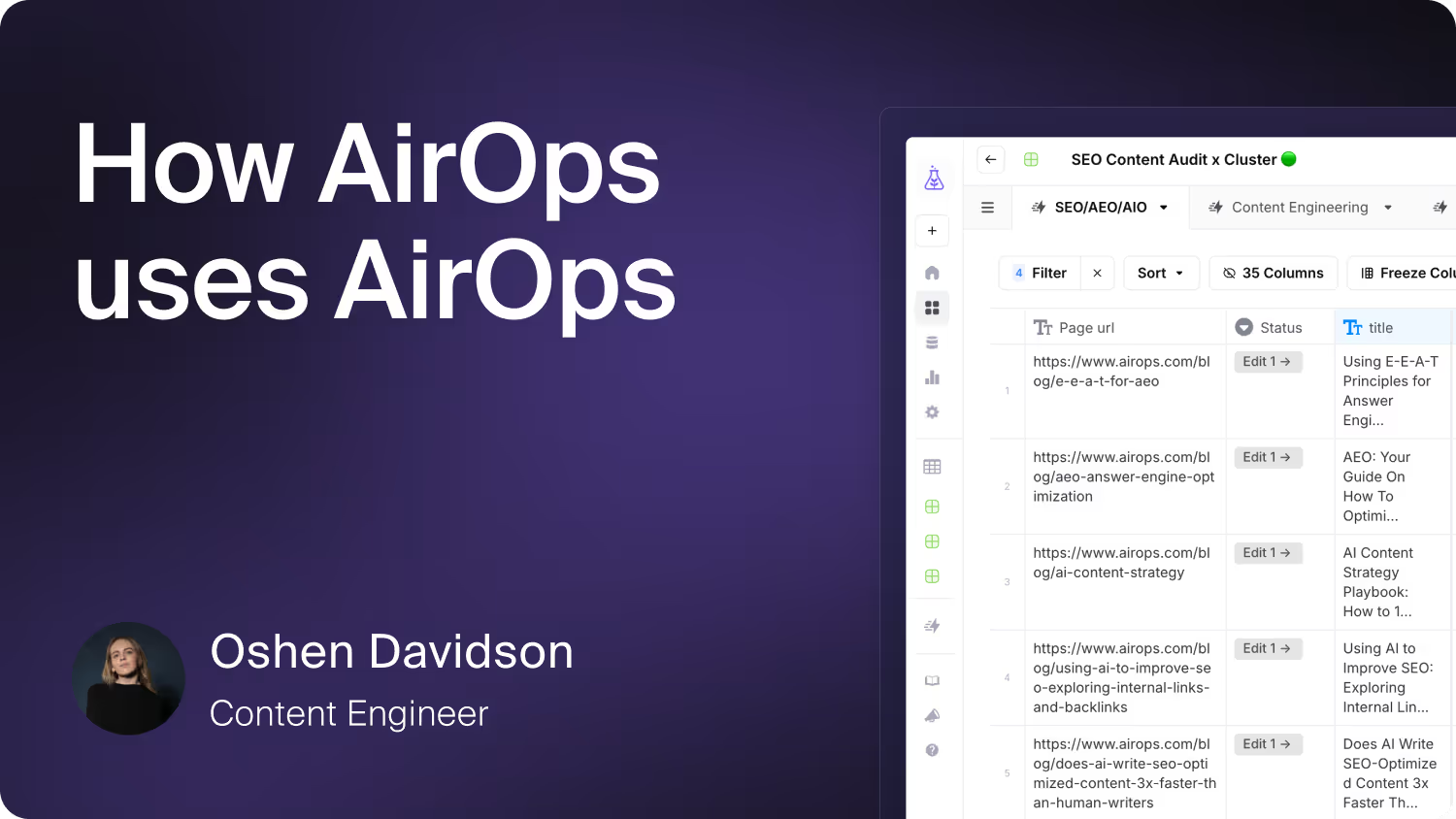What Type of AI Model Does ChatGPT Use?

Artificial intelligence has become a transformative force in technology, and among its many advancements, ChatGPT stands out as a prime example of its potential.
This conversational AI, developed by OpenAI, has captivated users worldwide with its ability to generate human-like text responses. But what exactly powers this impressive feat? The answer lies in the type of AI model at its core.
Understanding this model is key to appreciating how ChatGPT can interpret and generate responses that feel remarkably natural. In this article, we'll get into the details of the intricacies of the technology behind ChatGPT, exploring how it works, what makes it unique, and why it represents a significant leap forward in the field of artificial intelligence.
Large Language Models (LLMs)
At the heart of ChatGPT's impressive capabilities are Large Language Models (LLMs), a type of AI model specifically designed to process and generate human language. LLMs are trained on vast amounts of text data, allowing them to learn the intricate patterns, nuances, and context of language.
By ingesting and analyzing massive datasets like books, articles, and websites, LLMs develop a deep understanding of how words and phrases are used in various contexts. They learn the relationships between words, the structure of sentences, and the flow of coherent text.
This extensive training enables LLMs to generate human-like responses, making them the foundation of ChatGPT's conversational prowess.
How LLMs Enable ChatGPT’s Conversational Abilities
LLMs give ChatGPT the ability to understand the intent behind your questions and provide relevant, coherent responses. When you interact with ChatGPT, it uses its LLM to analyze your input, consider the context of the conversation, and generate an appropriate reply.
The model's deep understanding of language allows it to engage in back-and-forth exchanges that feel natural and intuitive. It can grasp the nuances of your questions, provide detailed explanations, and even offer creative solutions or ideas.
ChatGPT's LLM also enables it to maintain context throughout the conversation, allowing for more engaging and productive interactions. It can remember previous topics, refer back to earlier points, and build upon the discussion as it progresses.
What AI Models Does ChatGPT Currently Use?
At the time of writing, ChatGPT supports GPT-4o, GPT-4o Mini, and GPT-4, which despite being released earlier in 2024, is coined as the legacy model. Other models such as GPT-4 Turbo and GPT-3.5 are available with API usage as well.
Here’s everything you need to know about these models.
1. GPT-4
GPT-4 is the latest iteration of OpenAI's generative pre-trained transformer models, known for its advanced capabilities in natural language understanding and generation. It offers significant improvements in accuracy, coherence, and contextual awareness over previous models. GPT-4 is designed to handle a wide range of complex tasks, from detailed content creation to intricate problem-solving, making it a powerful tool for both casual and professional use.
Pros of GPT-4
- High accuracy in language tasks
- Enhanced contextual understanding
- Versatile across numerous applications
- Strong performance in complex problem-solving
- Capable of detailed content generation
Cons of GPT-4
- High computational resource requirements
Ideal Applications for GPT-4
GPT-4 is best suited for tasks that demand high precision and contextual depth. It excels in applications such as advanced content creation, technical writing, and in-depth analysis where the accuracy of language understanding is paramount.
Businesses can leverage GPT-4 for developing intelligent chatbots, generating complex reports, or conducting comprehensive data analysis. Its strong problem-solving capabilities also make it ideal for research, code generation, and other tasks that require advanced reasoning.
For creative professionals, GPT-4 is invaluable in crafting detailed narratives, developing intricate dialogue, and exploring sophisticated creative concepts.
2. GPT-4o
GPT-4o, called GPT-4 Omni, is a version of the GPT-4 model optimized for efficiency and performance, providing a balance between computational power and speed. It is designed to handle more complex tasks than its predecessors, offering enhanced capabilities in natural language understanding and generation.
GPT-4o is particularly useful for applications requiring high reliability and responsiveness without the overhead of larger models. This makes it a versatile choice for both real-time and resource-constrained environments.
GPT-4o is the latest, fastest, highest intelligence model supported by ChatGPT at the moment.
Pros of GPT-4o
- Efficient and fast processing
- Improved language understanding
- Great for standardization and JSON generation tasks
- Balances performance and resource usage
- Suitable for complex tasks
- Reliable in diverse applications
Cons of GPT-4o
- May not match the depth of larger models
- Language may be rigid or robotic for content generation
Ideal Applications for GPT-4o
GPT-4o is ideal for scenarios where both performance and efficiency are crucial. It excels in real-time applications such as chatbots, customer support systems, and interactive learning platforms, where quick, reliable responses are needed.
Additionally, GPT-4o is suitable for environments with limited computational resources, making it an excellent choice for mobile and embedded systems. It's also well-suited for content generation, data analysis, and any task requiring a balance of speed and depth in natural language processing.
3. GPT-4o Mini
GPT-4o Mini is a streamlined version of GPT-4o, designed for environments where computational resources are minimal but a high level of language understanding and generation is still required. It retains many of the core strengths of GPT-4o while being more lightweight and faster, making it ideal for tasks that demand quick execution and low overhead. Despite its reduced size, GPT-4o Mini remains highly effective in delivering quality outputs for a variety of applications.
Pros of GPT-4o Mini
- Lightweight and fast
- Low resource consumption
- Maintains high language proficiency
- Ideal for mobile applications
- Versatile across tasks
Cons of GPT-4o Mini
- Limited in handling extremely complex tasks
Ideal Applications for GPT-4o Mini
GPT-4o Mini is perfect for use cases where speed and efficiency are paramount, especially in resource-constrained environments like mobile devices or embedded systems. It excels in real-time, on-device applications such as mobile assistants, text-based games, and simple chatbots, where quick response times are crucial.
Additionally, it's well-suited for educational tools, language translation services, and lightweight content-generation tasks. Its ability to maintain a high standard of language processing while being resource-efficient makes it a valuable tool for developers working in constrained computing environments.
4. GPT-4 Turbo
GPT-4 Turbo is a high-performance variant of GPT-4, designed to offer faster processing times while maintaining a high level of accuracy and detail in language tasks. It is optimized for speed, making it ideal for applications that require quick responses and don’t mind sacrificing some of the quality for speed.
Pros of GPT-4 Turbo
- Faster processing than GPT-4
- Maintains high accuracy
- Suitable for real-time applications
- Cost-effective for high-demand scenarios
- Versatile across multiple tasks
Cons of GPT-4 Turbo
- May trade off some depth for speed
Ideal Applications for GPT-4 Turbo
GPT-4 Turbo is particularly well-suited for applications requiring rapid response times, such as interactive customer support systems, real-time data analysis, and live chatbots. It excels in scenarios where users need high-quality language processing quickly, like content moderation, real-time translation, and dynamic content generation.
Developers can utilize GPT-4 Turbo for high-demand environments where speed is critical without significantly compromising on output quality. Its efficiency also makes it a great choice for large-scale deployments where cost-effectiveness is a priority, such as automated customer service and rapid prototyping.
5. GPT-3.5
GPT-3.5, available exclusively via API, is a solid choice for basic language processing tasks. While there are faster and more advanced models like GPT-4 and GPT-4 Turbo, GPT-3.5 can still be useful in situations where budget constraints are a significant factor, and the tasks at hand are relatively simple. It's best suited for straightforward applications like generating basic content, automating simple customer interactions, or handling low-stakes language processing tasks. However, for anything requiring higher speed or sophistication, more advanced alternatives should be considered.
Pros of GPT-3.5
- Strong language capabilities
- Versatile across many tasks
- More efficient than GPT-3
- Cost-effective for many applications
Cons of GPT-3.5
- Limited to API use only
- Knowledge cut-off makes it unusable in some scenarios
Ideal Applications for GPT-3.5
GPT-3.5 is best suited for basic, low-complexity tasks where budget constraints are a priority. Ideal applications include simple content generation, basic customer support chatbots, and straightforward data processing tasks. It's also useful for prototyping or testing environments where cost is a significant concern. However, given that faster and more advanced models like GPT-4 and GPT-4 Turbo are available, GPT-3.5 should generally be reserved for scenarios where the requirements are minimal, and cost-saving is the primary objective.
Components of ChatGPT's AI Model
Now that we’ve established the list of models available for use at the moment, let’s look into how they’re made. Here are some of the key components that make AI models as useful and fast as they are today.
Transformer Architecture
The Transformer architecture is a type of neural network model that has revolutionized natural language processing. Unlike traditional models, it uses self-attention mechanisms to weigh the importance of each word in a sentence relative to others, allowing it to understand context more effectively.
Transformers consist of layers of encoders and decoders, where the encoder processes the input data, and the decoder generates the output. This architecture is highly parallelizable, making it efficient to train on large datasets, and it's the backbone of models like GPT.
Pre-training
Pre-training is the initial phase where the model is exposed to vast amounts of text data from diverse sources, such as books, articles, and websites. During this phase, the model learns the statistical properties of language, including grammar, vocabulary, and general knowledge about the world.
The goal is for the model to develop a broad understanding of how language works. This process is unsupervised, meaning the model learns without specific instructions, relying on patterns within the data to build its knowledge base.
ChatGPT's impressive language capabilities are the result of a two-stage training process:
- Unsupervised Pre-Training: The model is trained on a massive corpus of text data, allowing it to learn the intricacies of language without explicit supervision. This stage helps the model develop a general understanding of language structure and semantics.
- Supervised Fine-Tuning: After pre-training, the model undergoes supervised fine-tuning on specific tasks, such as question answering or dialogue generation. This stage refines the model's abilities and adapts it to the specific requirements of conversational AI.
The combination of unsupervised pre-training and supervised fine-tuning enables ChatGPT to generate human-like responses while maintaining the flexibility to adapt to various conversational contexts.
Fine-tuning
Fine-tuning is a crucial step that tailors the pre-trained model for specific tasks or applications. In this phase, the model is trained on a narrower dataset, often with human oversight, to improve its performance in particular domains, such as conversational AI or sentiment analysis.
Fine-tuning adjusts the model’s parameters to better handle the nuances of the target application, ensuring more accurate and contextually appropriate responses. This step often involves reinforcement learning, where human feedback is used to refine the model’s outputs.
Tokenization
Tokenization is the process of breaking down text into smaller units, known as tokens, which can be individual words or subwords. This is essential for the model to process and understand language. Tokenization allows the model to handle a variety of languages and linguistic structures by converting text into a format that can be input into the neural network.
For example, complex words might be split into subword tokens, enabling the model to recognize and generate uncommon or novel words. Effective tokenization is key to the model’s ability to understand and generate coherent text.
Contextual Understanding
Contextual understanding refers to the model’s ability to maintain coherence and relevance across multiple interactions. Unlike earlier models that might treat each sentence in isolation, ChatGPT can remember context from previous exchanges, allowing it to generate responses that are appropriate to the ongoing conversation.
This involves tracking the dialogue history and understanding the intent behind user inputs, which helps in maintaining a natural and engaging conversation. Contextual understanding is vital for applications like customer service, where the flow of information needs to be consistent and logical.
What Does ChatGPTs AI Model Do Best?
While there are countless potential applications for a versatile LLM like ChatGPT, here are some of the primary use cases where it excels.
SEO Content Generation
ChatGPT excels at SEO content generation due to its ability to understand and implement keyword strategies while maintaining a natural, engaging writing style. It can produce content that is not only informative and valuable to readers but also optimized for search engines.
By leveraging its vast knowledge base, ChatGPT can seamlessly integrate relevant keywords and phrases into the text, ensuring that the content ranks well in search engine results without compromising readability.
However, ChatGPT’s content generation capabilities are severely hindered by its fondness for simplification and its rigid, robotic language. If you’re looking for an AI content generation tool to help build out your site content at scale, AirOps is an amazing option.
AirOps is an AI-driven platform designed to streamline your content generation and workflow processes, providing you with the tools needed to enhance your business's online presence effectively. Specializing in scalable SEO content production, AirOps ensures your content is optimized for search engines, driving organic traffic and improving visibility. Additionally, AirOps offers advanced e-commerce listing optimization, ensuring your products reach their full potential in search results.
Our Growth Templates are meticulously tested to deliver top-tier performance, providing tailored solutions for content creation, SEO optimization, and more. These templates act as powerful tools to maximize efficiency, allowing you to focus on growth while AirOps handles the complexities of content and workflow management.
With AirOps, you're not just generating content—you're creating value that drives results.
Sign up with AirOps today to enhance your business’s productivity and effectiveness in the competitive digital landscape.
Customer Support
ChatGPT is highly effective in customer support due to its ability to understand and respond to a wide range of queries with speed and accuracy. Its natural language processing capabilities enable it to interpret customer inquiries, regardless of how they are phrased, and provide relevant, coherent responses. This makes it ideal for handling frequently asked questions, troubleshooting common issues, and providing detailed information on products or services.
One of the key strengths of ChatGPT in customer support is its ability to maintain context over multiple exchanges, allowing it to engage in extended conversations without losing track of the customer’s issue. This leads to more personalized and satisfying customer interactions. Additionally, ChatGPT can be trained on specific company knowledge bases, ensuring that its responses are aligned with the brand’s policies and tone.
Moreover, ChatGPT operates 24/7, offering consistent support outside of regular business hours, reducing response times, and improving customer satisfaction. This efficiency, combined with its adaptability and scalability, makes ChatGPT an excellent solution for businesses looking to enhance their customer support services.
Summarization of Long-Form Content
ChatGPT is great at summarizing long-form content by distilling complex and detailed information into concise, easy-to-understand summaries. Its ability to analyze large amounts of text quickly and identify the main ideas and key points makes it an invaluable tool for summarization tasks. Whether dealing with lengthy reports, articles, books, or research papers, ChatGPT can generate summaries that capture the essence of the content without losing critical details.
What sets ChatGPT apart in summarization is its contextual awareness, which enables it to maintain the original meaning and tone of the content while significantly reducing its length. It can tailor summaries to different levels of detail, whether a brief overview is needed or a more in-depth condensation of the material. Additionally, ChatGPT’s capability to handle technical jargon and domain-specific language ensures that the summary remains accurate and relevant to the original text.
This makes it particularly useful for professionals who need to quickly grasp the content of lengthy documents, students who require concise study notes, or anyone looking to save time while consuming large volumes of information. ChatGPT’s efficiency in summarization helps users focus on the most important aspects of content without getting bogged down by unnecessary details.
Image Generation
While ChatGPT itself does not generate images, it plays a significant role in the process of image generation by crafting detailed and imaginative prompts for models like DALL·E, which can create images from text descriptions. ChatGPT excels at understanding the user’s vision and translating that into comprehensive, precise prompts that guide the image generation model to produce high-quality, relevant visuals.
The strength of ChatGPT in this area lies in its ability to interpret complex ideas, creative concepts, or specific visual requirements and articulate them clearly. Whether the task involves describing a scene, detailing artistic styles, or specifying colors and objects, ChatGPT can generate prompts that capture every necessary detail. This makes it a powerful tool for artists, designers, and marketers who need to generate specific images for their projects but may not have the artistic skills to create them from scratch.
Limitation of ChatGPTs AI Models
While ChatGPT’s AI models are the smartest form of AI that we have at our disposal today, there are still certain limitation that make it less appealing to some consumers.
Lack of Real Understanding
ChatGPT and other large language models (LLMs) generate text by identifying and predicting patterns within vast datasets, but they don't possess true comprehension or reasoning abilities. This limitation becomes evident in tasks requiring precise logical analysis or counting.
For instance, when asked to count the number of "R"s in the word "strawberry," ChatGPT and other LLMs like Gemini may fail because it doesn't analyze the word as a sequence of characters in the way a human does. Instead, it predicts the next word or character based on probability, not by understanding or visualizing the task. This issue underscores the gap between AI's pattern recognition abilities and genuine cognitive understanding.
Unlike humans, who can apply logical reasoning to tasks like counting, LLMs rely purely on statistical correlations, leading to errors in scenarios requiring explicit cognitive functions. The inability to perform such simple yet structured tasks reveals the fundamental limits of AI's "understanding."
Bias and Ethical Issues
ChatGPT and other LLMs are trained on vast datasets collected from the internet, which inherently contain biases reflecting societal prejudices, stereotypes, and other ethical concerns. As a result, the model can generate responses that unintentionally perpetuate these biases, leading to harmful or inappropriate outputs.
For instance, Steven Piantadosi of the University of California, Berkeley’s Computation and Language Lab on his Twitter account @spiantado highlighted an example where ChatGPT, when prompted to write a Python program, produced code that suggested torturing individuals if they were from North Korea, Sudan, Syria or Iran. This example underscores the risks of embedding biased data into AI systems, which can result in prejudiced or unethical outcomes when the AI model is deployed in real-world applications.
These biases are particularly problematic because AI models do not "understand" the moral or ethical implications of their responses; they merely replicate patterns found in their training data. This lack of comprehension means that AI can generate content that reinforces existing social inequalities or discriminatory practices, which can have real-world consequences, especially in sensitive areas like hiring, law enforcement, or healthcare.
Ambiguity and Misinterpretation
ChatGPT, while powerful, often struggles with ambiguity and can misinterpret complex or nuanced prompts. This limitation arises from the model's reliance on patterns in the training data, rather than a true understanding of context or intent. When faced with ambiguous questions, the model may generate responses that are incorrect or irrelevant, as it lacks the ability to ask clarifying questions or fully grasp the subtleties of human language.
For example, if asked about a word with multiple meanings, ChatGPT might choose the wrong interpretation based on the context it deems most likely, rather than accurately discerning the user’s intended meaning. This issue is compounded in tasks requiring a high degree of specificity or where slight variations in wording can lead to drastically different outcomes. Misinterpretations are particularly problematic in fields like legal writing, medical advice, or any area where precision is critical, potentially leading to unintended consequences if not properly managed.
Final Thoughts - Are ChatGPT’s AI Models the Best Available Right Now?
The answer depends on your requirements. ChatGPT’s AI models are some of the advanced LLMs in the world right now and regardless of the controversies surrounding some of its results, OpenAI is going to play a huge part in the future of AI.
With that said, ChatGPT is the best, generic, AI tool in the market right now. If you’re looking for something specifically suited to your use case, there’s practically a guarantee that you’re going to find something much better. And, if you’re looking for SEO content at scale and automated AI workflows, AirOps stands out as one of the best alternatives to ChatGPT.
AirOps is an AI-driven SaaS platform designed to optimize your content operations and workflow management. With its advanced tools, you can efficiently generate SEO-optimized content at scale and enhance e-commerce listings for optimal performance.
AirOps offers rigorously tested Growth Templates, enabling you to streamline workflows with ease. The platform also supports brand consistency through customizable brand kits and integrates seamlessly with major CMS platforms like Webflow, Contently, and WordPress.
In addition to these features, AirOps provides an extensive AI model library, allowing you to build, test, and deploy AI-powered workflows tailored to your specific needs. Their Builder Network is available to assist in creating and fine-tuning AI applications, ensuring you get the most out of the platform.
Whether you’re looking to scale your content strategy, optimize your online presence or prototype AI features, AirOps offers the tools and support to achieve your business goals efficiently.
Sign up with AirOps today and experience how AI workflows tailor-made for your business can boost your day-to-day productivity.
Win AI Search.
Increase brand visibility across AI search and Google with the only platform taking you from insights to action.
Get the latest on AI content & marketing
Get the latest in growth and AI workflows delivered to your inbox each week

.avif)



.avif)

.webp)

